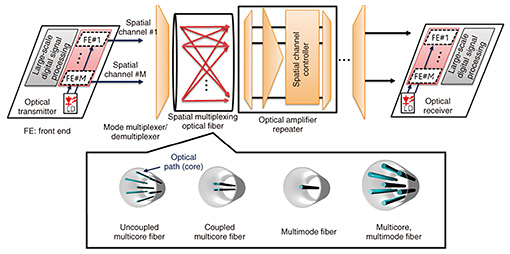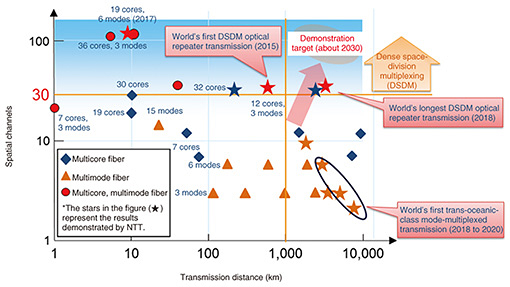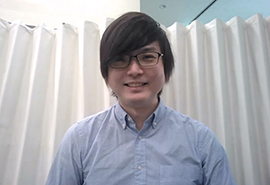 |
|
|
|
|
|
Rising Researchers Vol. 21, No. 4, pp. 11–15, Apr. 2023. https://doi.org/10.53829/ntr202304ri1  Petabit-class Optical Transmission Using Spatial Multiplexing Technology Opens a New Era with a Paradigm ShiftAbstractOver the last 40 years, various innovations in technology have improved our communications infrastructure, but it is becoming clear that the transmission capacity of current optical fiber technology will eventually reach its physical limits. In this interview, Distinguished Researcher Kohki Shibahara comments on the next generation of optical transmission technology that will overcome these limits, in particular, a dense space-division multiplexing based on a new kind of optical fiber that will enable a dramatic scale-up from the current terabit-class to petabit-class capacities. Keywords: dense spatial multiplexing, cyclic mode permutation, interference cancellation Petabit-class dense spatial-multiplexing optical transmission technology targeting an unknown optical communications infrastructure—What is petabit-class dense spatial-multiplexing optical transmission technology? This technology uses a new kind of optical fiber, that we call space-division-multiplexing optical fiber, to achieve much higher transmission capacity than is possible with current technology. As you know, the optical communications infrastructure, which uses optical fiber as the transmission medium, enables us to communicate in real time across the globe. Although the transmission capacity of optical fiber has steadily increased over the years thanks to various innovations in technology, we expect it to eventually reach a physical limit if the existing forms of optical fiber cannot be improved. The reason is that optical fiber is made of glass, which may melt by the high optical power originating from a large number of wavelength channels. Another problem is that the optical signal is distorted by the physical properties of the glass medium. As a result, the maximum transmission capacity of long-distance networks is estimated to be about 100 terabits per second per fiber. Space-division-multiplexing optical fiber will enable us to achieve a dramatic scale-up from the current terabit class of transmission capacity to the petabit class, and we are working now on developing optical transmission technology that uses this optical fiber. —Specifically, what sort of research are you doing on this new technology? Up to now, the capacity of the optical communications infrastructure has grown by developing new multiplexing axes. For example, in the wavelength-division multiplexing currently in use, multiplexing is done on the wavelength axis. That is, different information is carried by different colors of light that are bundled together and transmitted over a single optical fiber. In a similar way, the space-division multiplexing used in our research bundles together multiple light paths, namely cores or modes, along the spatial axis in an optical fiber to expand capacity. In this approach, the theoretical transmission capacity scales in accordance with the number of cores in a multicore fiber (Fig. 1).
A major problem, however, is that modal dispersion and mode-dependent loss occur in a transmission through multimode fiber, which can carry multiple optical signals in different ways through a single core. Modal dispersion causes a variation in the signal arrival time at the receiver due to there being a spread in transmission times for different modes in a multimode fiber. An intuitive explanation for modal dispersion is like this: light propagation in a fiber is often likened to the phenomenon of total internal reflection. In conventional single-mode fiber, the angle of reflection is very large, but when the number of modes is high, the angle of reflection becomes small, and this difference results in a delay in the signal arrival time. The increased time difference becomes a performance-limiting factor. Mode-dependent loss causes differences in the intensity distributions of the various modes in the fiber and it tends to occur when there is a misalignment of cores at the fiber connection points. The effects of mode dispersion and mode-dependent loss accumulate over distance, and this was a particularly important problem that had to be solved for long-haul terrestrial and submarine optical networks to be capable of high-capacity and high- quality transmissions over distances exceeding 1000 km. —How are you trying to solve the technical problems related to the capacity and quality of transmissions? To reduce the effects of the problems I mentioned earlier, my colleagues and I are proposing cyclic mode permutation and interference cancellation as key technologies. In 1000-km class transmissions, optical-amplifier repeaters amplify the signal along the link. So, instead of a long-distance transmission in a single mode, the spatial mode is changed in each repeater section, thus averaging out the effects of modal dispersion and mode-dependent loss. We achieved high-quality transmissions by using an interference canceler to eliminate crosstalk, which is interference between the signals in the optical transmission. Interference cancelers are widely used in radio communications, but we modified them to work over the rapidly changing environment in optical transmissions. We were the first in the world to apply cyclic mode permutation and interference cancellation and are considering how to use them to solve various problems. —Can you tell us some of your recent results? My colleagues and I at NTT have set world records for optical transmission distance using multimode fiber and multicore-multimode fiber, achieving 6300 km with three-mode fiber in 2018, 3000 km using multicore-multimode fiber, also in 2018, and 3250 km using six-mode fiber in 2020, all world records in terms of distance. Those results demonstrated that long-distance optical transmission can be achieved with multimode fiber as well as with multicore fiber. The key aspects one has to consider when fabricating cables comprising spatial multiplexing fiber include manufacturing cost, durability, and connectivity with peripheral devices as well as transmission performance. We therefore believe that increasing the number of candidates for future submarine optical networks will help to lower the cost of future systems. We also believe that the accumulation of mode dispersion and mode-dependent losses over distance remains an issue when it comes to constructing long-haul transmission systems, so it will be important to continue doing experiments on mode-multiplexing transmission over long distances to verify its feasibility as infrastructure. On the joy of doing research that has resulted in a new paradigm—Could you tell us about your research objectives and vision for the future? New applications and services that use telecommunications are coming out every day and the optical communications infrastructure that supports them “under the hood” must also continue to evolve to fully accommodate the continually increasing telecommunications traffic. The All-Photonics Network (APN) initiative, one area of work in support of the Innovative Optical and Wireless Network (IOWN), has set as a target an increase in transmission capacity by a factor of 125, and space-division multiplexed optical transmission technology is needed to achieve that target. To realize the IOWN concept, we will continue to expand transmission capacity by combining with relevant technologies that have shown remarkable progress, including optical bandwidth extension technology using efficient optoelectronic devices and high symbol-rate technology that makes the use of the signal space more efficiently. The actual system deployment of spatial multiplexing technology will start in the mid-2020s with, I believe, up to ten light paths per optical fiber. However, the transmission capacity that can be supported with ten paths per fiber will become insufficient very soon after that. We would therefore like to work on a long-haul optical transmission infrastructure with the goal of having 100 or so spatially multiplexed optical fibers with even more optical paths. This research and development would support sustainable development of the optical communications infrastructure (Fig. 2).
—What are some important aspects of research for you? I hope to do work that will leave a legacy even hundreds of years into the future. The spatial-multiplexing optical transmission technology that I am working on is an attempt to change the structure of optical fibers, which has not changed significantly in the last 40 years. This technology is creating a tidal change in the optical fiber field, but the effects also extend to related peripheral technology, such as optical transceivers, optical amplifiers, optical devices, and connections. That makes it challenging to set up an experimental verification system that integrates prototypes of optical and electrical devices that have not yet reached technological or market maturity. But, on the other hand, it has been a great joy for me, as a researcher, to be involved in the development of technology that has led to an important paradigm shift after such a long interval of time. People set records in various endeavors, such as sports or architecture, but, for me, it is working hard to perform the worlds-first or world-class research and have it published in international journals and conference proceedings. When my work is published in a scientific journal, I feel that I’ve contributed to the history of human science, even if it is just a small step, and that is very rewarding. —Dr. Shibahara, please leave us with a message for other researchers, students, and business partners. NTT Network Innovation Laboratories, where I work, covers a very broad range of fields that include technologies that push the limits of communications, such as radio and optical communications, as well as technologies for achieving high efficiency and high functionality. That means there is much interaction and collaboration with various other laboratories at NTT that deal with devices, systems, and applications. I think that is a strength which facilitates technical exchanges with fields that are peripheral to communications, both within NTT and outside the company. In optical communications, for example, we have experts on devices such as optical fiber, optical amplifiers, and optical modulators, as well as experts in key technologies related to optical transmission systems, such as networking. These people are all within our company, so that makes consultation with experts easy. Before joining NTT, I had never been involved in information and communications technology at all, because I majored in geophysical science up to my master’s degree. When I became involved in optical communications technology in my work at NTT, however, I came to realize how broad this field of technology is and how it can absorb various peripheral fields of technology, and that continues to surprise me even now. When focusing on electrical and electronic engineering and communications engineering in relation to basic communications systems and related devices, for example, knowledge of light propagation and control, statistics for analyzing and processing signals, computer science, information theory, and signal processing theory are all very useful. Optical devices also relate to material science and quantum chemistry. For applications, there have been many studies of application to cryptography, quantum computing, and machine learning and deep learning, which have become popular fields with the rise of artificial intelligence. So we can see that communications technology is an extremely challenging and rewarding field that brings together the best of cutting-edge science and technology and offers opportunities for people of many backgrounds to play active roles. Also, when outside the company, there are many situations in which I feel the benefits of the strong connections with industry, government, and academia that have grown from the achievements of my predecessors. NTT laboratories are fully equipped for research and development; our people and facilities are producing world-class results in many challenging areas of research. I hope that those who wish to contribute to society through research and development will come to NTT and work together with us in this new era.
■Interviewee profileKohki Shibahara joined NTT in 2010, after receiving an M.S. degree from the Department of Geophysics at the Graduate School of Science of Kyoto University. He received a Ph.D. from the Department of Communications and Computer Engineering of the Graduate School of Informatics at Kyoto University in 2017. He has been engaged in research and development on next-generation high-capacity optical transmission systems as a Distinguished Researcher at NTT Network Innovation Laboratories since 2022. He received the Tingye Li Innovation Prize from Optica in 2016 and the Academic Encouragement Award from the Institute of Electronics, Information and Communication Engineers (IEICE) in 2017. |
|











